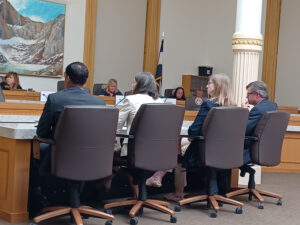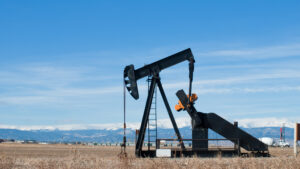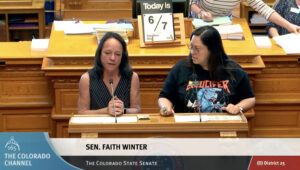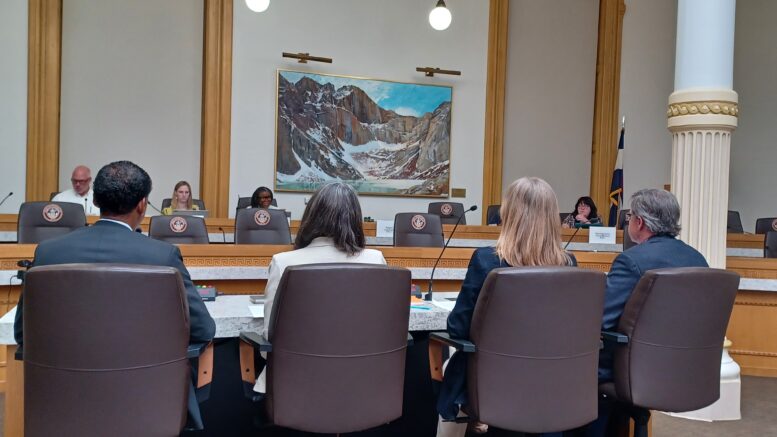An interim legislative committee began its investigation Friday into the range of factors contributing to ozone pollution, but much of the conversation and suggestions about fixes zeroed in quickly on the oil and gas industry.
The Legislative Interim Committee on Ozone Air Quality sprang from this year’s House Bill 1294, which began as a wide-ranging attempt to boost regulations around air-quality permitting but was negotiated down to a law that imposed minor changes in the area and established the committee. Eight legislative Democrats and four Republicans are charged with analyzing strategies to improve ground-level ozone issues that plague the upper Front Range, and Gov. Jared Polis directed them in a June signing statement to focus on ozone sources ranging from power plants to the transportation sector rather than just on sources from oil-and-gas operations.
Committee members first heard an extensive presentation from the Colorado Department of Public Health and Environment and the Colorado Energy and Carbon Management Commission about the problems caused by ground-level ozone and the source of the gas. Just 29% of the ozone that can cause respiratory irritation and cardiovascular problems is human-caused — as opposed to 61% circulating throughout the world naturally — but state officials said they concentrate on the smaller allotment because that’s what they can affect.
The highest levels of volatile organic compounds and nitrogen oxides — the two gases that become ozone when mixed with sunlight — come from the oil and gas industry, though new technologies are expected to reduce 2011 VOC levels by more than two-thirds by 2026. However, vehicles, off-road engines powering things like mobile machinery and lawnmowers, industrial plants and consumer products like cleaners also contribute to ozone, explained Garry Kaufman, deputy director of regulatory affairs for the Colorado Air Pollution Control Division.

The panel of state officials that talked Friday to the interim ozone-quality committee included (L to R): Air Pollution Control Division Director Michael Ogletree; CDPHE environmental health and protection director Trisha Oeth; Energy and Carbon Management Commission Deputy Director Mimi Larsen; and APCD Deputy Director of Regulatory Affairs Garry Kaufman.
Myriad efforts to reduce emissions
As part of its implementation plan to bring an area from Douglas County north to the Wyoming border back into alignment with federal ozone standards — it sits in a state of severe nonattainment versus 2008 standards — the state has taken many actions. It expanded oil and gas regulations beginning in 2019, began planning closures of coal-fired power plants in 2020, tied transportation improvements to emissions reductions in 2021 and this year established building performance standards as it plans further rules for industrial facilities.
But all those efforts have yet to bring the upper Front Range back into compliance, setting putting Colorado in jeopardy of losing its ability to take corrective action and instead be subject to a federal implementation plan. And the frustration that’s engendered among environmental advocates and residents of the northern Denver metro area who are subject to ozone alerts and as many as 67 days a year of poor ozone conditions led to HB 1294 and the interim committee.
Trisha Oeth, CDPHE director of environmental health and protection, told the committee the solutions that have been put into place will take time to produce results, even as VOCs and NOx emissions both fell by more than 25% from 2011 to 2016 and remain on a downward path. The transition from gas-powered to electric vehicles will have a big impact, she said, but the state is working on proposals across sectors — including one it’s developing now, by order of Polis, to reduce nitrous oxides from drilling sites.
“Ozone is a very complex challenge, from how it’s formed to how it’s affected by meteorology and climate,” Oeth said. “There is no one solution to ozone pollution.”
A focus on oil and gas

Oil pumpjack against snowy mountains in Colorado.
Yet, Rebecca Curry, Colorado policy counsel for environmental organization Earthjustice, also offered in a presentation that she offered to the committee that oil and gas was the greatest contributor to the problem. Modeling done by her organization predicted it would be responsible for 47% of NOx by 2026 — well more than the 24% coming from non-road engines — and 34% of VOCs, just slightly more than the 30% contribution of consumer products.
Curry, in turn, suggested that state implementation plans that have focused on reducing ozone pollution have missed an opportunity to stop creation of new sources by boosting regulations on minor sources of emissions that have a big impact when taken as a whole. Those minor sources include individual oil-and-gas wells and modifications to refineries, and she suggested legislators should step up to take such actions that state regulators so far haven’t.
“We have to stop permitting things that cause air-quality problems. And I’m not saying you should deny all permits,” Curry said. “If we continue to add pollution to the air through permitting more construction, there’s no way there’s no way we can use reductions alone to get into compliance.”
Representatives from several other environmental organizations, testifying as part of the public-comment period of the committee hearing, offered suggestions for even more significant changes for oil-and-gas permitting. Colorado Coalition for a Livable Climate legislative analyst Jan Rose proffered that permits should be granted only on a one-for-one basis when other drilling sites are shut down, and 350 Colorado climate policy analyst Heidi Leathwood said that permit denials need to increase until the state bans the drilling of any new wells.
Fears of too narrow a focus for ozone solutions

Colorado state sens. Faith Winter and Julie Gonzales discuss changes to their air-quality permitting reform bill in May in the Senate.
Sen. Faith Winter, D-Westminster, also expressed frustration at the seeming ease with which the CECMC approves permits, asking whether it’s required for citizens to have attorneys to take part in the permitting process and whether a permit has been denied because of community protest. Though she didn’t offer a proposed solution, she asked at one point if the law requires the CECMC to reject a permit application if it finds there are negative cumulative impacts from the approval of new wells. (It does not.)
Comments like these perturbed several Republican members of the committee. Rep. Gabe Evans of Fort Lupton asked exactly how much closer to attainment a focus solely on oil and gas operations would get the state, and Sen. Barbara Kirkmeyer said that it seemed officials and committee members wanted just to focus on one industry to solve Colorado’s ozone problem.
“It just appears from the slides here and from everybody’s questions that we just want to go after oil and gas,” Kirkmeyer said. “And I want to know what effect that will have on dealing with ozone across the state.”
The committee is scheduled to meet four or five more times, beginning on Sept. 26, and to discuss issues ranging from community impacts to ozone contribution factors to the viewpoints of industry and labor. It does not have the power to propose bills as most interim committees do, but members can still take suggestions coming out of the hearings and mold them into the five bills that each individual legislator is permitted to introduce.
